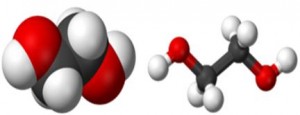This Ethylene Glycol Chemical Engineering Final Year Project report is about Ethylene glycol Chemical. The project has fourteen chapters of long and complete description of Ethylene glycol. This project report discusses a common element of radiator fluid. Ethylene glycol is an organic combine widely used as an automotive liquid and a precursor to polymers. In its pure form, it is an odorless, colorless, syrupy, sweet-tasting liquid.

Ethylene glycol is toxic, and ingestion can result in death. Ethylene glycol is not to be confused with DIETHYLENE glycol, heavier ether DIOL, or with polyethylene glycol, a nontoxic polyether polymer. Ethylene glycol is used as a protecting group for carbonyl groups in organic synthesis. In the plastics industry, ethylene glycol is important precursor to polyester fibers and resins. Polyethylene TEREPHTHALATE, used to make plastic bottles for soft drinks, is prepared from ethylene glycol.
It is used to increase the boiling point and decrease the freezing point of radiator fluid, which circulates through the automotive radiator. These changes to the boiling and freezing points result from the colligative properties of the solute that is they depend on the number of particles in the solution. Hence, ethylene glycol is added to prevent the radiator from overheating or freezing, depending on the season.
Fluoresce in dye is often added to radiator fluid to help identify the source of a leak. The fluoresce in the fluid fluoresces when viewed under ultraviolet light. The toxic alcohols are parent compounds that exert most of their toxicity by conversion to metabolites. Finally, the proposed analysis approach is described, as are the various ancillary concepts required for its implementation.
Ethylene Glycol Chemical Engineering Final Year Project Conclusion:
In conclusion of the Ethylene glycol report, it is tastes sweet, which is why some animals are attracted to it. Many veterinarians are familiar with ethylene glycol toxicity because of the frequent cases that involve dogs or cats that drink radiator fluid.
Download Ethylene Glycol Chemical Engineering Final Year Project.
